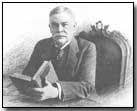Primary Documents - Thomas Nelson Page on the Tenth and Eleventh Battles of the Isonzo, 1917
 Reproduced below is an
account of the outcome of the
tenth and
eleventh battles of the Isonzo, launched by the Italian
Commander-in-Chief
Luigi Cadorna in May and
August 1917.
Reproduced below is an
account of the outcome of the
tenth and
eleventh battles of the Isonzo, launched by the Italian
Commander-in-Chief
Luigi Cadorna in May and
August 1917.
Although these were both regarded as expensive failures by many, Page's summary - he served as U.S. Ambassador to Italy at the time - instead emphasised the greater attritional losses inflicted upon the already weakened Austro-Hungarian army.
Click here to read the view of the head of the British Red Cross effort in Italy, G.M. Trevelyan.
Thomas Nelson Page, U.S. Ambassador to Italy, on the Tenth and Eleventh Battle of the Isonzo
The Allies had planned a great offensive for early spring on all their fronts.
The late opening of the spring in 1917, however, prevented until May the great offensive which Cadorna had planned on the Carso front to force the Austrians from their strong positions above the upper and middle Isonzo, where their right - to employ the words of the Italian report - "pivoted on a lofty mountain system, consisting of various lines of high peaks, each of which was a dominating base connected with its neighbour; so that, taken together, they formed a formidable defensive whole."
Such were the enemy's lines between the middle Isonzo and the Chiapovano and Idria valleys, extending to the system of the Ternovo plateau, and to the mountainous line on the right of the Vipacco River to the north and east of Gorizia.
Hence - to quote from the same authority - they extended "through the narrow valley of the Vipacco to the northern edge of the Carso, at Monte Faiti, and joining the Cornem-Brestovizza-Hermada-Duino bulwark, extended down to the sea."
As soon as the weather conditions permitted, Cadorna opened his offensive from the bridge head at Plava, and sent the Italians up the precipitous steeps of Monte Kuk, Mount Vodice, and "Hill 625."
The dash of the assault carried against desperate resistance the Austrian first line, while farther toward the sea the Italian right advanced on the Carso, sweeping the Austrian left out of their strongest positions "as far as the immediate approaches to Faiti, to Brestovizza, and to Monte Hermada."
By May 27 the Italians had reached the third line of Austrian defences and crossed the Ternovo. The offensive was costly, for the Italians were forced to carry by assault against Austria's best troops positions which, naturally of tremendous strength, had been fortified by Austria's highest experts till they were deemed the impregnable bulwarks of the Dual Kingdom.
But if the Italian losses were tremendous, they also exacted a heavy toll from the defenders. So successful was this May offensive that Austria felt compelled to draw important reinforcements from her eastern front to defend these gateways to Trieste.
Cadorna was now complete master of the initiative, and he prepared for his next step, which was to assemble a superior force with superior artillery, and attack once more along the whole Isonzo front.
Again he was successful. His left thrown against the Austrian right captured the advanced Bainsizza plateau and the positions on Monte Santo as far as the Chiapovano Valley, and then made a flank attack against the positions of Ternovo and an attack by both front and flank on the positions on Mount San Gabriele.
On the Carso the Third Army under the Duke d'Aosta carried the enemy's first line, and then, to quote the Italian report, "made a determined bid for Monte Hermada, the most important bulwark barring his advance on Trieste."
But there must be a limit to all effort, however epic its scope or exercise may be. Against these bulwarks Italy's offensive came for the time to a stand. She had poured out her blood like water on those rock mountain sides and plateaus, where every point and line were swept by a fire that cut away woods as a harvest-field is mown by the scythe, and blew away the living rock in its elemental fury.
This offensive in which Italy was forced to put forth her utmost efforts had cost her heavily - how heavily was not divulged. But she had to show for it substantial gains. She had smashed the enemy's powerful lines and, against the most stubborn resistance, had carried his most cherished defences, in a region where every position seized was the proof at once of her success and of her prowess.
She had captured over 30,000 prisoners, 135 guns, including several of the famous "305's," nearly 400 machine-guns and trench mortars, and a prodigious quantity of military supplies and other stores of all kinds.
With the proof of her ability to capture, against Austria's most powerful efforts at resistance, defences so formidable that military writers had long considered them impregnable, Italy might well feel satisfied.
But not only had she strengthened her own position; she had rendered, if it were known, a vast service to the Allied cause. First, in that while Russia was crumbling internally, her armies were as yet intact.
And that they had remained so was due in part to Italy's having compelled Austria to withdraw from the Russian front troops which, if left there, might have changed the situation months before the Russian armies gave way, and thus have permitted German reinforcements from the weakened Russian front to fling their weight on the already worn French and British armies at the crucial moment when they were straining every nerve on the Meuse, the Aisne, and the Somme.
Source: Source Records of the Great War, Vol. V, ed. Charles F. Horne, National Alumni 1923
"Coffin Nails" was a term used by British soldiers to describe cigarettes.
- Did you know?
